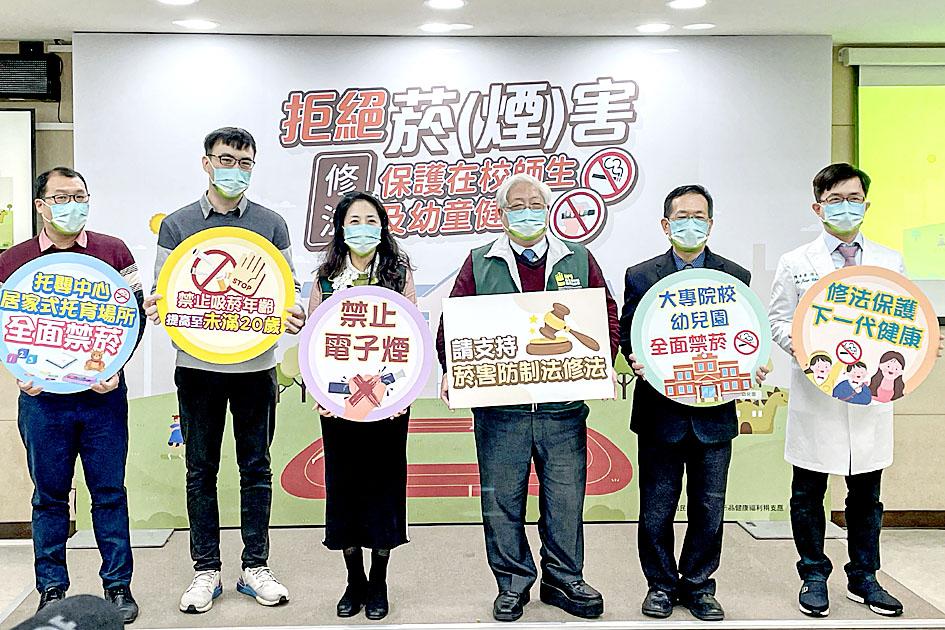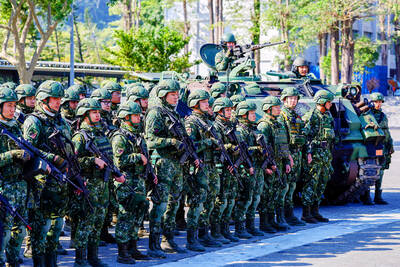Electronic cigarette use among college students more than doubled between 2018 and 2020, especially among women, who are now more likely to smoke e-cigarettes than traditional cigarettes, a Health Promotion Administration (HPA) survey found.
The Ministry of Health and Welfare agency yesterday shared the results at a news conference in Taipei to encourage the passage of a law that would ban the growing industry.
The Executive Yuan on Jan. 13 passed amendments to the Tobacco Hazards Prevention Act (菸害防制法) that seek to ban e-cigarettes and flavored tobacco products outright.

Photo: Chiu Chih-jou, Taipei Times
It would also raise the legal smoking age to 20 from 18, and expand a smoking ban in public areas to include indoor and outdoor spaces at universities, preschools, daycare and live-in childcare centers.
The bill is currently awaiting deliberation in the legislature, making it unclear when it might pass into law.
Meanwhile, more people are becoming addicted to vaping — another word for e-cigarette use — attracted by its trendiness and enticing flavors, the HPA said.
Six reported cases of lung damage between February 2020 and September last year are also potentially linked to vaping, adding to growing evidence worldwide of its associated dangers, HPA Tobacco Control Division Director Chen Miao-hsin (陳妙心) said.
Experts highly suspect three of the cases in men aged between 16 and 56 to be caused by vaping, while the other three — a 22-year-old woman, a 31-year-old man and a 42-year-old man — reported asthma likely exacerbated or induced by vaping, she said.
Duration of use spanned a half month to four years, while five also smoked traditional cigarettes and one had previously quit, she added.
Most of the top 10 causes of death in Taiwan are linked to smoking, totaling at least 20,000 people every year, said Chen Mu-jung (陳木榮), a pediatrician at Your Doctor Clinic in New Taipei City.
Put another way, someone dies of a smoking-related condition every 20 minutes, he added.
In its survey, the HPA found that although there was little change in traditional cigarette use among college students between 2018 and 2020, vaping increased dramatically from 2.5 to 5.4 percent.
There was also a rise in people who reported using both, from 1.5 percent in 2018 to 2.5 percent in 2020.
Sole usage of e-cigarettes jumped from 1 percent to 2.5 percent over the period, showing that vaping is rising in popularity on college campuses, even among those who do not smoke cigarettes, the agency said.
Also worthy of note was its popularity among women, with 3.2 percent of female college students vaping to only 1.9 percent who smoke cigarettes.
Most respondents chose to start using e-cigarettes because of their variety of flavors (30.9 percent), as well as not wanting a tobacco flavor (29.6 percent), peer pressure (28.9 percent) and because they believe vaping does not pose a serious health risk (24.9 percent).
Campus exposure to secondhand smoke also slightly increased from 47 to 48.8 percent over the period, meaning that about half of college students reported being regularly exposed to secondhand smoke.
It is most prevalent in smoking areas (34.6 percent), followed by campus entrances (23.7 percent) and open spaces (18.2 percent).
More than 7,000 kinds of chemicals are found in the tobacco of traditional cigarettes, 93 of which are carcinogenic, Chen Mu-jung said.
However, vaping oil can contain as many as 15,000 types of additives, including more than 41 harmful substances, he said.
There have been many cases reported internationally of lung damage linked to vaping, and now cases are appearing in Taiwan, he added.
The HPA and doctors urged support for the amendments, as legal assistance could help “protect the health of the next generation.”

UNILATERAL MOVES: Officials have raised concerns that Beijing could try to exert economic control over Kinmen in a key development plan next year The Civil Aviation Administration (CAA) yesterday said that China has so far failed to provide any information about a new airport expected to open next year that is less than 10km from a Taiwanese airport, raising flight safety concerns. Xiamen Xiangan International Airport is only about 3km at its closest point from the islands in Kinmen County — the scene of on-off fighting during the Cold War — and construction work can be seen and heard clearly from the Taiwan side. In a written statement sent to Reuters, the CAA said that airports close to each other need detailed advanced

Tropical Storm Fung-Wong would likely strengthen into a typhoon later today as it continues moving westward across the Pacific before heading in Taiwan’s direction next week, the Central Weather Administration (CWA) said. As of 8am, Fung-Wong was about 2,190km east-southeast of Cape Oluanpi (鵝鑾鼻), Taiwan’s southernmost point, moving westward at 25kph and possibly accelerating to 31kph, CWA data showed. The tropical storm is currently over waters east of the Philippines and still far from Taiwan, CWA forecaster Tseng Chao-cheng (曾昭誠) said, adding that it could likely strengthen into a typhoon later in the day. It is forecast to reach the South China Sea

Almost a quarter of volunteer soldiers who signed up from 2021 to last year have sought early discharge, the Legislative Yuan’s Budget Center said in a report. The report said that 12,884 of 52,674 people who volunteered in the period had sought an early exit from the military, returning NT$895.96 million (US$28.86 million) to the government. In 2021, there was a 105.34 percent rise in the volunteer recruitment rate, but the number has steadily declined since then, missing recruitment targets, the Chinese-language United Daily News said, citing the report. In 2021, only 521 volunteers dropped out of the military, the report said, citing

WEATHER Typhoon forming: CWA A tropical depression is expected to form into a typhoon as early as today, the Central Weather Administration (CWA) said yesterday, adding that the storm’s path remains uncertain. Before the weekend, it would move toward the Philippines, the agency said. Some time around Monday next week, it might reach a turning point, either veering north toward waters east of Taiwan or continuing westward across the Philippines, the CWA said. Meanwhile, the eye of Typhoon Kalmaegi was 1,310km south-southeast of Oluanpi (鵝鑾鼻), Taiwan’s southernmost point, as of 2am yesterday, it said. The storm is forecast to move through central